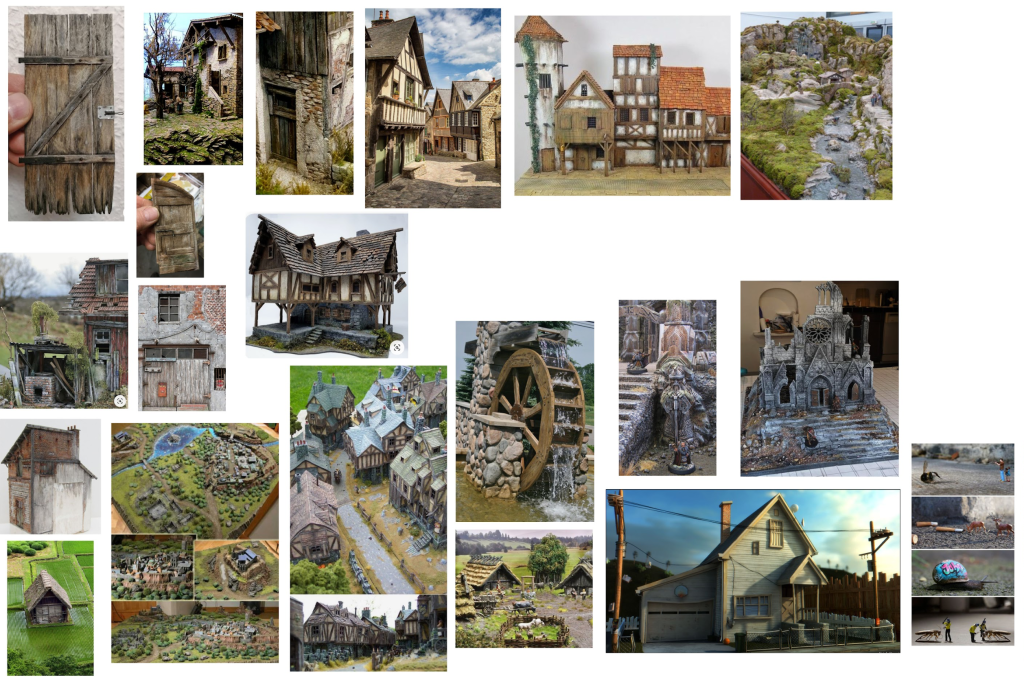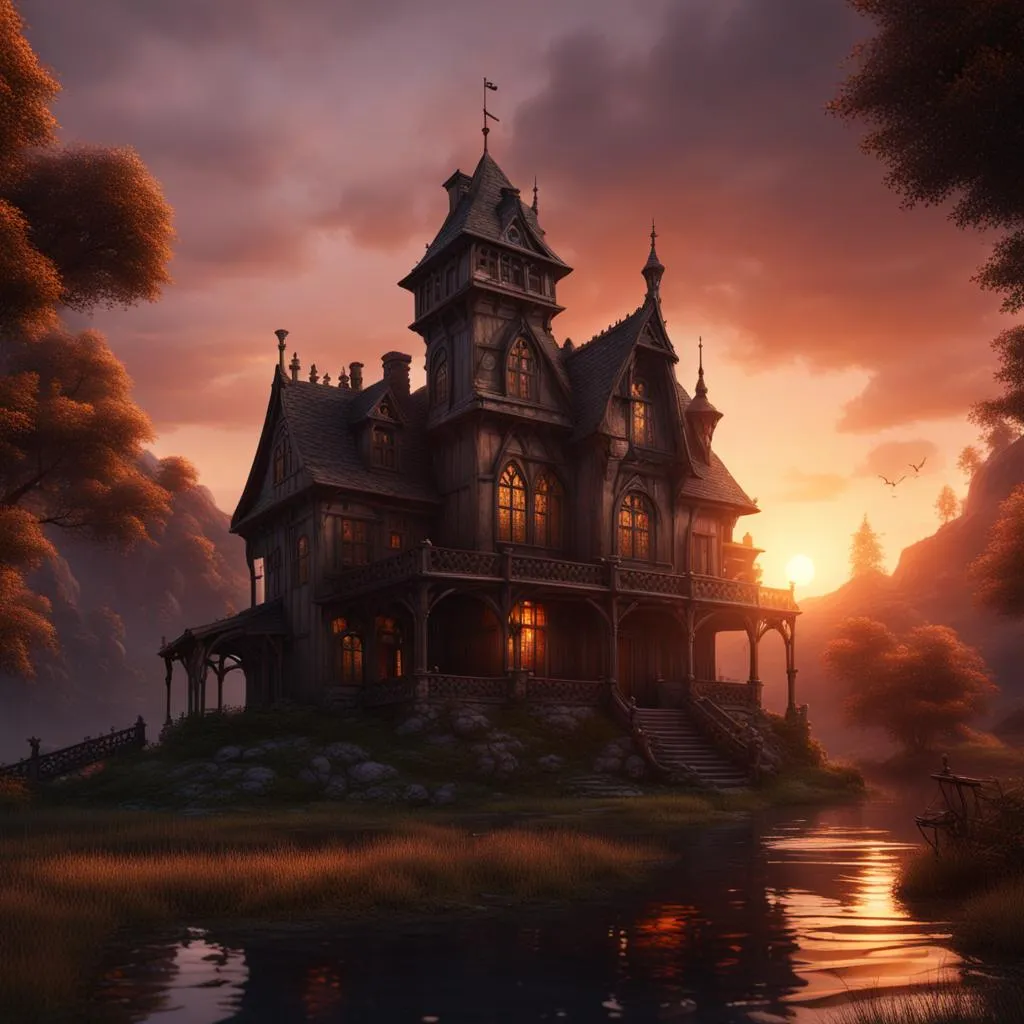So, we’ve been exploring the idea; we’ve been trying to get inspiration, and I think at this point there is enough for other people in the team to get their teeth into. But this brings up one of the big designer problems you have. How do you get a picture that’s formed in your mind into other people’s minds?
And make sure it’s the same picture?
Because very often in the past when I’ve tried to do this, I’ve made the mistake of saying ridiculous things like, “Oh yeah, it’s kind of like a medieval scene and it’s foggy streets and it’s, you know, it’s autumn,” and let them create something out of that simple sentence.
But after you make that mistake, you realise what they need is enough information so that what they create, what they sketch and what they draw, and what they code even, is going to be the same as the picture in your mind. Otherwise, you end up with a cacophony of imagery. Which can be useful by the way – you can find the diamond in rough – but more often if you don’t explain your idea clearly enough, if you don’t try and get people into the right mindset, you’ll end up with just the colour brown.
You end up with loads and loads of different sketches, but none of them really fit what you want.
You’re not doing the right job as a designer. So inspiring people in the right way so they create the right image is both incredibly expensive, because it takes people days, if not weeks, to create the scene that you want them to create, and it’s incredibly demoralising, because someone spends – and that’s really what makes a great artist, by the way, in my view, the passion that they put into their project – if you are trying to get a concept artist or a general artist to do something, and you look at it and they put their heart and soul into it, and you then turn around and say, “Yeah, but not like that,” It’s just awful for them.
So what there has to be is, there has to be a real conversation about what you want them to create. It’s not as simple as saying, you know, I’ll just create something beautiful. It’s a deep and meaningful conversation. And very often the conversation is more about feel than look, because if you inspire them in a certain way where you say, “I want roofs that are pointy, they should be brown, made of brown slate,” then they go and do just that. But they’re the experts in this. They’re the ones that should decide the little details. You don’t want to paint the picture for them. You want to get the best out of them. So it’s about look and it’s about feel. But it is less about look and more about feel. And it’s also about quality.
When I talk to the press, I’m really talking to them in the same sort of way that I talk to the people that I work with. You know, it’s an inspiring way. And I think it’s completely right to say, “Look, we want this to look great. It’s got to be great. Just by just looking at a single screenshot from any point of view, people have got to go, that looks amazing.”
It’s got to feel unique and it’s going to feel different, but it’s going to feel familiar. Those sort of very bold, let’s make something great, statements. I think you have to use those when you’re trying to explain an idea. You have to make the person creating this uncomfortable because you’re pushing them. You’re pushing them against the edges of their skill.
What you don’t want to do, and what they absolutely do want you to do is, you don’t ever want to say, “Make it like that, but better.”
That defines their vision, and people will take something that looks like one thing and they’ll make it slightly better. So you referring to other games is the route to sameness – to a sameness about graphics and gameplay and everything else that makes up a game.
And that’s not what I personally like to strive for. I like to strive for uniqueness and originality and pushing the envelope of what I and the team, and hopefully the people that play the games, think of as gaming. So that’s why I’ve loved and adored creating everything from Populous to Magic Carpet, to Dungeon Keeper, to Black & White, and even to Fable – that element of uniqueness.
If it’s time to inspire people to create concept art, to do prototypes, then this blog really should talk about how you prepare for something like that.
You can do things like mood boards. I’m quite a fan of mood boards. Even if it’s me doing mood boards. If I do a mood board, I don’t do an actual physical one. That would be ridiculous. I use Keynote. It’s free on the Mac, and it’s just beautifully put together. It’s not fiddly. It’s just a joy to use. If I’m trying to inspire concept, I’ll grab images from the internet. And it is so much easier now that we have this.

In the earlier days, we didn’t have things like Keynote or the internet even. We had to use reference books or, or photographs we’d taken. So I’ll use those boards, but I won’t put a huge amount of text in those boards. And I prepare what I’m going to say, because what I’m doing is preparing for a conversation.
I’m going to call it a conversation rather than calling it a meeting, because a meeting implies that you are telling people exactly what to do, what pixel to draw, and what piece of code to write. So this conversation has to happen in a kind of living way. So I’m preparing all the materials for that, but most crucially, I’m preparing the narrative of what I’m going to say, and I can’t stress that more strongly.
Getting the narrative absolutely right to play out in your head, I’ll really prepare it and take it seriously. So when I’m sitting down with someone and I’m trying to explain what’s in my mind, I’m prepared for that. I know what points I’m going to hit.
I know and honestly feel the bits of what I’m going to say that are most exciting, that I almost get emotional about because I’m so excited to have that conversation. So while I’m preparing that message, I’m preparing the kind of virtual mood board. And I’ll quite often, before having that really crucial conversation, I’ll try and find some people who are patient enough that I can explain the idea to and have a little practice conversation, because you can’t practice with the person you are inspiring. So ultimately, when I’m ready, when I’ve got the narrative, and I’ve got all the materials, the next thing I need to do is find the great people to inspire, to create those prototypes.
And I’m so lucky, and this is an incredible advantage, in having worked with such brilliant people, That means that I can ask people I’ve worked with in the past if they could help out and do some work. And there’s one person that I’ve worked with in the past that really stuck in my mind, and his name’s Kareem Ettouney, and he is so sublimely talented. He’s just an amazing, incredible person. I chose him because he’s got an incredible mind.
He’s like a force of nature.
Sitting down with Kareem and talking through the idea and the feel, the look of the game and the feel of the game, the feel that you want a player to have that moment they see one shot of the game – that conversation has led to a number of sketches.

And these sketches are really, really quickly done. They’re not incredibly detailed drawings. They’re not supposed to be a proof of what the graphics intend to do. They’re really just the beginning of this conversation about what the game should look like.
In the past, this conversation was easy because I had this amazing person, Paul McLaughlin, every game that I’d worked on from Syndicate on that syndicate in 1990, 1989, right up until Legacy, he was the Art Director.
And Paul, we had worked together so long that I could sit down with Paul, show him the mood board, have a conversation, and he would say, okay, and he’d go off and come back with an almost identical and quite often improved image of what was in my mind. But sadly, and it was a great personal sadness, Paul passed away in 2021.
Trying to find a great Art Director who actually would be willing to work with someone like myself has been really challenging. I didn’t want to put the idea on the shelf until we did find that great art director, so I was in the incredibly lucky position to reach out, to be able to reach out to Kareem, who is undoubtedly one of the greatest of great people I’ve worked with.
And Kareem has got this wonderful way of taking an idea and exploring it and enhancing it. So Kareem and I had this fantastic conversation. I referred to my mood board. I managed to hit all the gameplay points. And you can always tell when something works when the person that you are having this conversation with is actually feeding back and saying, well, does that mean this? Does that mean that? And Kareem did that in absolute spades. I was as equally inspired as he was.
So because this blog is a piece of serial information, as in you read it sequentially, I need to explore what actually happens in a serial way. But I’m not going to do that entirely because there are some things I’m not going reveal at this point, simply because I want to justify some of those points beforehand.
But I will share with you some of the mood boards that I put together. And I’m also going to share some of the sketches that came out of our conversation. And I think what that’s going to do is, it’s going to give you some hints about what this game is. What I would say to you as you’re reading, don’t presume the obvious, because what we are doing is exploring something fresh and new and different, in this familiar environment anyway, because this week is the week that we are releasing Legacy, which is another unique gameplay solution to a problem. So I’m gonna keep this blog short and get back to the launch.

But before I go, a little bit of fun. I’m adding a link here at the bottom to give you a chance to be in the designer’s seat for a litle. Have a look at this survey, and see what you’d chose if you were presented with these images at the early concepting stage. I’d be very interested to see if you think along the same lines as I do. Some of these images were presented to me, some I’ve grabbed myself as examples of what I would have presented.